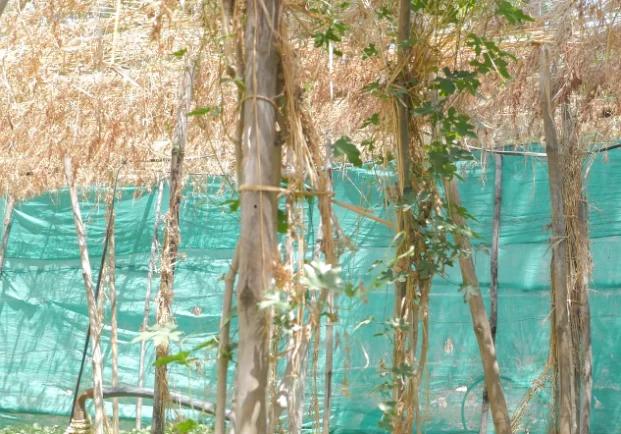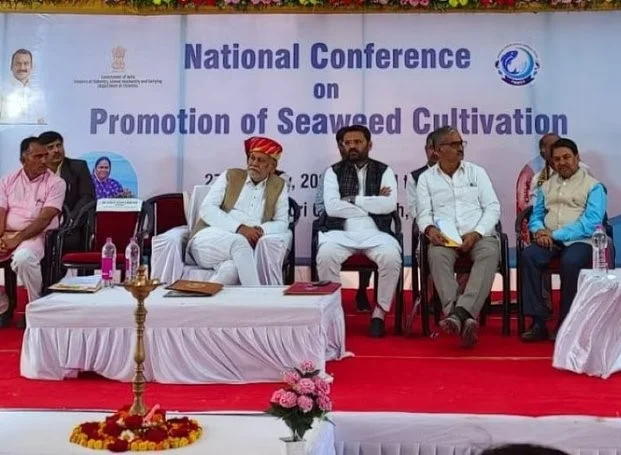Akash Chourasiya, a forward-thinking farmer hailing from Sagar in Bundelkhand, Madhya Pradesh, has found success in his 2.5-acre farm through the implementation of multilayer cropping, allowing him to generate an impressive annual income of Rs 15 lakh.
In the realm of multilayer farming, as explained by Akash, “We engage in planting four different varieties of crops on the same field. This involves four distinct layers of crops. The first crop is nestled within the soil, followed by another layer, and then two additional crops above the first two. The strategic arrangement includes ginger planted beneath the surface, green vegetables positioned above that layer, scarlet gourd flourishing to a height of about 7 feet, and towering over it all is the presence of papaya.”

This innovative approach to farming has proven to be a lucrative endeavor for Akash Chourasiya, demonstrating the potential of multilayer cropping in enhancing agricultural productivity and income for marginal farmers.
In managing his 2.5-acre multilayered farm, Akash Chourasiya employs a diverse combination of plants. To provide essential shade, he incorporates bamboo and grass, which are either cultivated on the farm or purchased. Akash notes, “Even if we have to buy it, the estimated cost of acquiring grass and bamboo for one acre is about Rs 1.5 lakh. This investment is required once every five years, translating to an annual cost of about Rs 30,000 per acre. The total investment amounts to approximately Rs 4 lakh. However, the returns are substantial, with a gross profit of 15-16 lakh per year and a net profit ranging from 11-12 lakh from my 2.5-acre farm.”
Also Read: Shankarlal Damor’s Remarkable Transition From Rickshaw Puller to Organic Farming
In addition to the main crops, Akash diversifies his income streams by engaging in the sale of vermicompost and milk.

Multilayer cropping stands out as a sustainable and cost-effective farming method, requiring minimal labor input. Akash Chourasiya, shedding light on the process, explains, “In February, we initiated the planting with ginger beneath the surface and green amaranth above it. Additional greens like fenugreek, spinach, and coriander can also be cultivated. This approach brings threefold benefits. Firstly, within 2-3 weeks of planting, these plants cover the ground surface entirely, preventing the growth of weeds or grass. This effectively eliminates the need for costly deweeding measures and deters insects that thrive on weeds from infesting the field.”
Akash emphasizes a unique practice, stating, “We don’t just trim the leaves of the plants; instead, we uproot them entirely. By planting ginger below the surface, uprooting the entire plant helps avoid interference with ginger plant growth. This uprooting process not only helps in weed control but also contributes to loosening the topsoil, facilitating the penetration of sunlight and oxygen. This, in turn, promotes the health of the crops below, ultimately saving us money. Additionally, the cultivation of green vegetables ensures a daily income stream for us.”
Also Read: Corporate Business Head Quits Job to Teach Mud House Construction
The use of local materials like bamboo and wild grasses to create shade eliminates the necessity for expensive polyhouses in Akash Chourasiya’s farming approach.

Akash elaborates, “This type of farming cannot be conducted in an open setting, as it would adversely affect the quality and yield. Therefore, what we do is create a shading structure with bamboo and grass. This structure ensures that the plants receive the optimal balance of sunlight and shade. Even during the peak of summer, the yield remains impressive. The bamboo poles not only provide support for the vines of scarlet gourd but can also bear the weight of other gourd varieties with small leaves. In addition, we cultivate papaya in this plot, maintaining a distance of 12×18 feet between each tree. By July, the papaya plant outgrows the shade and begins fruiting from September, with harvesting starting in December.”
The multilayer cropping system employed by Akash Chourasiya ensures a consistent income for farmers throughout the entire year.
As Akash highlights, “Our greens provide us with a daily income from March to July. In April, the scarlet gourd begins fruiting and remains a source of revenue until November. Come August, we have a bulk harvest of ginger. The papaya harvest extends from December to January. Consequently, from March to February of the following year, we maintain a steady year-round income.”
The shade structure in Akash Chourasiya’s farming not only provides protection but also serves as a sustainable and biodegradable solution.
Akash explains, “The shade serves as a shield against heat, ground frost, and hailstorms. When hailstorms occur, they first encounter the grass roof, melting before reaching the ground. This effectively reduces damage from adverse weather events associated with climate change.”

Furthermore, Akash has successfully minimized the cost of purchasing expensive vegetable seeds by exclusively using indigenous seeds. He states, “Indigenous seeds exhibit greater resistance to harsh weather conditions, have prolonged fruiting periods, and are less susceptible to pest attacks.”
In addition to these benefits, multilayer farming, as practiced by Akash, proves to be water-efficient, a crucial factor in water-scarce regions like Bundelkhand.
Akash clarifies, “When you cultivate 4-5 types of plants, it creates ample shade that slows down evaporation. This results in a significant reduction in water consumption. The water intended for one crop becomes sufficient for managing four crops.”
The method of farming adopted by Akash Chourasiya demonstrates a minimal occurrence of pest attacks, and pest control is achieved without resorting to chemical means.

Akash details, “The primary challenge comes from flying insects that lay eggs and pose a threat to plants. To address this issue, we employ crop guards in the farm. These sheets are yellow and blue, resembling the colors of flowers. Mustard oil and jaggery are applied to these sheets. The vivid colors attract flying insects, and once trapped, they are unable to reproduce, effectively controlling their population without the need for harmful chemicals.”
In addition to his crop cultivation, Akash Chourasiya is actively involved in the production of vermicompost, contributing to a supplementary income of Rs 1.5 to 1.75 lakhs annually.

Akash provides insight, stating, “We produce approximately 40 tonnes of vermicompost per year, utilizing 4-5 tonnes for our own needs and selling around 35 tonnes. The vermicompost is priced at Rs. 5000 per tonne.”
Around 80% farmers in India have land holdings less than 5 acres. This method of farming can be a boon for the marginal farmers in our country.
Akash extends his knowledge to fellow farmers through a commendable initiative, organizing a two-day training program every month. He has successfully trained over 50,000 farmers across the country.

Explaining the program, Akash says, “We conduct a two-day training program every month on the 27th and 28th, free of cost. Farmers from all over the country participate, where we guide them on the importance of indigenous seeds, organic farming, indigenous cattle-based farming, cost reduction strategies, multilayer farming, and more. It serves as a platform for comprehensive discussions on these crucial topics.”
Akash Chourasiya has dedicated efforts to develop numerous crop combinations tailored for multilayer farming, generously sharing his knowledge with fellow farmers.

Expressing his expertise, Akash mentions, “I have formulated 12-15 types of crop combinations specifically designed for multilayer farming.” This commitment to innovation and knowledge-sharing contributes to the success and sustainability of multilayer farming practices, benefiting a wider community of farmers.









